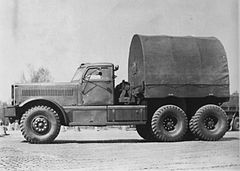- Diamond T 980
-
The Diamond T 980 was a heavy tank transporter developed early in World War II.
Designed as a heavy prime mover for tank transporting, the 980 was the product of the Diamond T Company in Chicago. In 1940 the British Purchasing Commission, looking to equip the British Army with a vehicle capable of transporting larger and heavier tanks, approached a number of American truck manufacturers to assess their models. The Diamond T Company had a long history of building rugged, military vehicles for the U.S. Army Quartermaster Corps and had recently produced a prototype heavy vehicle for the US Army which, with a few slight modifications met British requirements and an initial order for 200 was very quickly filled.
The result was the 980, a 12-ton hard-cab 6x4[1] vehicle which proved to be one of the most successful and memorable in its class.[citation needed] Powered by a 895 cu in (14.67 l) Hercules DXFE OHV inline six diesel engine[2] developing 185 bhp (138 kW) with Bosch fuel injection,[2] or the 1,090 cu in (17.9 l) Hall-Scott 440 OHV inline-six gasoline engine (the largest gasoline engine in any WW2 military truck)[2] of 240 bhp (180 kW),[2] and geared very low, it could pull a trailer load of up to 120,000 lb (54,000 kg),[3] and proved capable of the task of moving the heaviest tanks then in service.
With a single dry-plate clutch, It had a four-speed manual constant-mesh transmission plus a similar three-speed auxiliary gearbox, for a total of twelve forward and three reverse speeds, driving through Timken double-reduction differentials.[2] Airbrakes were standard.[2] The electrics were 24-volt.[2] Top speed was 23 mph (37 km/h), and with 150 US gal (120 imp gal; 570 l) fuel, maximum range was 300 mi (480 km)..[2]> Wheelbase was 179 in (4,500 mm), length 280 in (7,100 mm), track 74 in (1,900 mm), and height 100 in (2,500 mm).[2] Steering was manual, with no power assist.[2] The weight was 26,500 lb (12,000 kg), with GVW of 45,000 lb (20,000 kg)[2]
A winch of 40,000 lb (18,000 kg) capacity, chain driven off the top of the auxiliary transmission and intended mainly for hauling damaged tanks aboard trailers, was mounted behind the cab.[2]
The 981 was the same chassis with open cab (no top) and cargo box.[4] Both the 980 and 981 used a cab design similar to the 4-ton truck.[2]
Contents
Service
Production began in 1941.[2] The first batch of the vehicles was received in Britain in 1942 and very quickly demonstrated their rugged reliability in the British campaign in North Africa. Battle-damaged tanks needed to be quickly recovered, often under hostile fire, and returned to workshops for repair. The Diamond T, with its well trained Royal Army Service Corps crew and powerful engine and winch, could accomplish this, even in the harshest desert conditions.[citation needed]
5,871 were built by 1945[2] and were used by virtually every Allied army in every theatre of WWII. The British Army took delivery of around 1,000 during the war years. It suffered from "very limited off-road performance" as a result of only the two rear axles being driven.
Today many of the 60 year-old Diamond T's can still be found in private ownership in Britain and frequently appear at historic vehicle shows.[citation needed]
U.S. nomenclature
This combination unit is referred to as the M19 tank transporter, consisting of the M20 tractor and M9 24-wheel trailer. In the nomenclature system used by the U.S Army Ordnance Corps Supply Catalog this vehicle is referred as the G159. It was superseded by the M26, which would use the same Hall Scott 440 engine.[2] After the introduction of the M26, the U.S. relegated M20s to ammunition hauling, for which they proved "tremendous".[2]
See also
Notes
References
- Berndt, Thomas. Standard Catalog of U.S. Military Vehicles 1940-1965. Iola, WI: Krause Publications, 1993. ISBN 92-72123.
- TM 9-2800
- TM 9-768
- TM 9-1768A
- TM 9-1825A
- TM 9-1827A
- TM 9-1829A
- SNL G159
External links
Categories:- Tank transporters
- Military trucks
Wikimedia Foundation. 2010.

